|
Albatross |
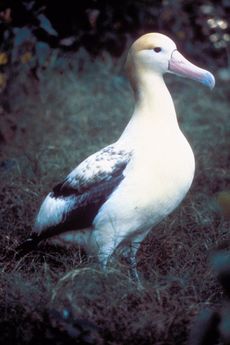
Short-tailed Albatross (Phoebastria
albatrus)
|
|
Scientific classification |
| Kingdom: |
Animalia
|
| Phylum: |
Chordata
|
| Class: |
Aves
|
| Order: |
Procellariiformes
|
| Family: |
Diomedeidae
G.R. Gray, 1840 |
|
| Genera |
Diomedea
Thalassarche
Phoebastria
Phoebetria |
Albatrosses, of the biological
family Diomedeidae, are large
seabirds allied to the
procellariids, storm-petrels and diving-petrels in the order
Procellariiformes (the tubenoses). They range widely in the
Southern Ocean and the North Pacific. They are absent from
the North Atlantic, although fossil remains show they once occurred there too.
Albatrosses are amongst the largest of
flying birds, and the
great albatrosses (genus
Diomedea) have the largest wingspans of any
extant birds. The albatrosses are usually regarded as
falling into four genera, but there is disagreement over the
number of species.
Albatrosses are highly efficient in the air, using
dynamic soaring and slope soaring to cover great distances
with little exertion. They feed on squid, fish and krill by
either scavenging, surface seizing or diving. Albatrosses
are colonial, nesting for the most part on remote oceanic
islands, often with several species nesting together. Pair
bonds between males and females form over several years,
with the use of ritualised dances, and will last for the
life of the pair. A breeding season can take over a year
from laying to fledging, with a single
egg laid in each breeding attempt.
Of the 21 species of albatrosses recognised by the IUCN,
19 are threatened with extinction. Numbers of albatrosses
have declined in the past due to harvesting for feathers,
but today the albatrosses are threatened by introduced
species such as rats and feral cats that attack eggs, chicks
and nesting adults; by pollution; by a serious decline in
fish stocks in many regions largely due to overfishing; and
by long-line fishing. Long-line fisheries pose the greatest
threat, as feeding birds are attracted to the bait and become hooked on the lines and drown.
Governments, conservation organisations and fishermen are
all working towards reducing this by-catch.
Albatross biology
Taxonomy and evolution
The albatrosses comprise between 13 and 24 species (the
number of species is still a matter of some debate, 21 being
the most commonly accepted number) in 4 genera. The four
genera are the great albatrosses (Diomedea), the mollymawks
(Thalassarche), the North Pacific albatrosses (Phoebastria),
and the sooty albatrosses or sooties (Phoebetria). Of the
four genera, the North Pacific albatrosses are considered to
be a sister taxon to the great albatrosses, while the sooty
albatrosses are considered closer to the mollymawks.
The
taxonomy of the albatross group has been a source of a great
deal of debate. The Sibley-Ahlquist taxonomy places seabirds,
birds of prey and many others in a greatly enlarged
order Ciconiiformes, whereas the ornithological
organisations in North America, Europe, South Africa,
Australia and New Zealand retain the more traditional order
Procellariiformes. The albatrosses can be separated from the
other Procellariiformes both genetically and through morphological characteristics,
size, their legs and the arrangement of their nasal tubes (see
Morphology and flight).
Within the family the assignment of genera has been
debated for over a hundred years. Originally placed into a
single genus, Diomedea, they were rearranged by
Reichenbach into four different genera in 1852, then lumped
back together and split apart again several
times, acquiring 12 different genus names in total (though
never more than eight at one time) by 1965 (Diomedea,
Phoebastria, Thalassarche, Phoebetria,
Thalassageron, Diomedella, Nealbutrus,
Rhothonia, Julietata, Galapagornis,
Laysanornis, and Penthirenia).
By 1965, in an attempt to bring some order back to the
classification of albatrosses, they were lumped into two
genera, Phoebetria (the sooty albatrosses which most
closely seemed to resemble the procellarids and were at the
time considered "primitive" ) and Diomedea (the
rest).[1]
Though there was a case for the simplification of the family
(particularly the nomenclature), the classification was
based on the morphological analysis of
Elliott Coues in 1866, and paid little attention to more
recent studies and even ignored some of Coues's suggestions.

Phylogenetic relationships of the 4 albatross
genera. Based on Nunn et al 1996.
More recent research by Gary Nunn of the American Museum
of Natural History (1996) and other researchers around the
world studied the mitochondrial DNA of all 14 accepted
species, finding that there were four, not two, monophyletic
groups within the albatrosses.[2] They proposed the
resurrection of two of the old genus names, Phoebastria for
the North Pacific albatrosses and Thalassarche for the
mollymawks, with the great albatrosses retaining Diomedea
and the sooty albatrosses staying in Phoebetria. Both the
British Ornithologists' Union and the South African
authorities split the albatrosses into four genera as Nunn
suggested, and the change has been accepted by the majority
of researchers.
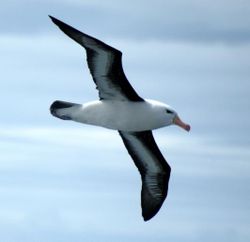
Black-browed Albatross, a mollymawk.
While there is some agreement on the number of genera,
there is less agreement on the number of species.
Historically, up to 80 different taxa have been described by
different researchers; most of these were incorrectly
identified juvenile birds.[3]
Based on the work on albatross genera, Robertson and Nunn
went on in 1998 to propose a revised taxonomy with 24
different species,[4]
compared to the 14 then accepted. This interim taxonomy
elevated many established subspecies to full species, but
was criticised for not using, in every case, peer reviewed
information to justify the splits. Since then further
studies have in some instances supported or disproved the
splits; a 2004 paper analysing the mitochondrial DNA and
microsatellites agreed with the conclusion that the
Antipodean Albatross and the Tristan Albatross were distinct
from the Wandering Albatross, per Robertson and Nunn, but
found that the suggested Gibson's Albatross, Diomedea
gibsoni, was not distinct from the Antipodean Albatross.[5]
For the most part, an interim taxonomy of 21 species is
accepted by the IUCN and many other researchers, though by
no means all — in 2004 Penhallurick and Wink called for the
number of species to be reduced to 13 (including the lumping
of the Amsterdam Albatross with the Wandering Albatross),[6]
although this paper was itself controversial[3]
[7]. On all sides, there is the widespread
agreement on the need for further research to clarify the
issue.
Sibley and Ahlquist's molecular study of the evolution of
the bird families has put the radiation of the
Procellariiformes in the Oligocene period (35–30 million
years ago), though this group probably originated earlier,
with a fossil sometimes attributed to the order, a seabird
known as Tytthostonyx, being found in late Cretaceous rocks
(70 mya). The molecular evidence suggests that the
storm-petrels were the first to diverge from the ancestral
stock, and the albatrosses next, with the procellarids and
diving petrels separating later. The earliest fossil
albatrosses were found in Eocene to Oligocene rocks,
although some of these are only tentatively assigned to the
faimly and none appear to be particularly close to the
living forms. They are Murunkus (Middle Eocene of
Uzbekistan), Manu (early Oligocene of New Zealand), and an
undescribed from from the Late Oligocene of South Carolina.
Similar to the last was Plotornis, formerly often considered
a petrel but now accepted as an albatross. It is from the
Middle Miocene of France, a time when the split between the
four modern genera was already underway as evidenced by
Phoebastria californica and Diomedea milleri, both being
mid-Miocene species from Sharktooth Hill, California. These
show that the split between the great albatrosses and the
North Pacific albatrosses occurred by 15 mya. Similar fossil
finds in the southern hemisphere put the split between the
sooties and mollymawks at 10 mya.[8] The fossil record of
the albatrosses in the northern hemisphere is more complete
than that of the southern, and many fossil forms of
albatross have been found in the North Atlantic, which today
has no albatrosses. The remains of a colony of Short-tailed
Albatrosses have been uncovered on the island of Bermuda,[9]
and the majority of fossil albatrosses from the North
Atlantic have been of the genus Phoebastria (the North
Pacific albatrosses); one, Phoebastria anglica, has been
found in deposits in both North Carolina and England. See the genus accounts for more data on fossil
species.
Morphology and flight
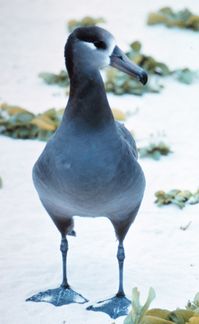
Unlike most Procellariiformes, albatrosses, like
this Black-footed Albatross, can walk well on
land.
The albatrosses are a group of large to very large
birds; they are the largest of the procellariiformes.
The
bill is large, strong and sharp-edged, the upper
mandible terminating in a large hook. This bill is composed
of several horny plates, and along the sides are the two
"tubes", long nostrils that give the order its name. The
tubes of all albatrosses are along the sides of the bill,
unlike the rest of the Procellariiformes where the tubes run
along the top of the bill. These tubes allow the albatrosses
to have an acute sense of smell, an unusual ability for
birds. Like other Procellariiformes they use this olfactory
ability while foraging in order to locate potential food
sources.[10] The feet have no hind toe and the three
anterior toes are completely webbed. The legs are strong for
Procellariiformes, in fact, almost uniquely amongst the
order in that they and the giant petrels are able to walk well on land.
The adult
plumage of most of the albatrosses is usually some
variation of dark upper-wing and back, white undersides,
often compared to that of a
gull. Of these, the species range from the Southern
Royal Albatross which is almost completely white except for
the ends of the wings, to the Amsterdam Albatross which has
an almost juvenile-like breeding plumage with a great deal
of brown, particularly a strong brown band around the chest.
Several species of mollymawks and North Pacific albatrosses
have face markings like eye patches or have grey or yellow
on the head and nape. Three albatross species, the
Black-footed Albatross and the two sooty albatrosses, vary
completely from the usual patterns and are almost entirely
black (or dark grey in the case of the Light-mantled Sooty
Albatross). Albatrosses take several
years to get their full adult breeding plumage.
The
wingspans of the largest great albatrosses (genus Diomedea)
are the largest of any bird, exceeding 340 cm (over 11
feet), although the other species' wingspans are
considerably smaller. The wings are stiff and cambered, with
thickened streamlined leading edges. Albatrosses travel huge
distances with two techniques used by many long-winged
seabirds, dynamic soaring and slope soaring. Dynamic soaring
enables them to minimise the effort needed by gliding across
wave fronts gaining energy from the vertical wind gradient.
Slope soaring is more straightforward: the albatross turns
to the wind, gaining height, from where it can then glide
back down to the sea. Albatross have high glide ratios,
around 1:22 to 1:23, meaning that for every metre they drop,
they can travel forward 22 metres. They are aided in soaring
by a shoulder-lock, a sheet of tendon that locks the wing when fully extended, allowing
the wing to be kept up and out without any muscle
expenditure, a morphological adaptation they share with the
giant petrels.[11]
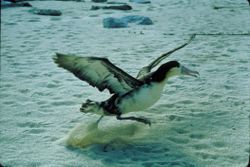
Taking off is one of the few times albatrosses
use flapping in order to fly, and is the most
energetically demanding part of a journey.
Albatrosses combine these soaring techniques with the use
of predictable
weather systems; albatrosses in the southern hemisphere
flying north from their colonies will take a clockwise
route, and those flying south will fly counterclockwise.[12]
Albatrosses are so well adapted to this lifestyle that their
heart rates while flying are close to their basal heart
rate when resting. This efficiency is such that the most
energetically demanding aspect of a foraging trip is not the
distance covered, but the landings, take-offs and hunting
they undertake having found a food source.[13]
This efficient long-distance travelling underlies the
albatross's success as a long-distance forager, covering
great distances and expending little energy looking for
patchily distributed food sources. Their adaptation to
gliding flight makes them dependent on wind and waves,
however, as their long wings are ill-suited to powered
flight and most species lack the muscles and energy to
undertake sustained flapping flight. Albatrosses in calm
seas are forced to rest on the ocean's surface until the
wind picks up again. They also sleep while resting on the
surface (and not while on the wing as is sometimes thought).
The North Pacific albatrosses can use a flight style known
as flap-gliding, where the bird progresses by bursts of
flapping followed by gliding.[14]
When taking off, albatrosses need to take a run up to allow
enough air to move under the wing to provide
lift.
Distribution and range at sea

The distribution of albatrosses across the
world.
Most albatrosses range in the southern hemisphere from
Antarctica to Australia, South Africa and South America. The
exceptions to this are the four North Pacific albatrosses,
of which three occur exclusively in the North Pacific, from
Hawaii to Japan, California and Alaska; and one, the Waved
Albatross, breeds in the Galapagos Islands and feeds off the
coast of South America. The need for wind in order to glide
is the reason albatrosses are for the most part confined to
higher latitudes; being unsuited to sustained flapping
flight makes crossing the doldrums extremely difficult. The
exception, the Waved Albatross, is able to live in the
equatorial waters around the Galapagos Islands because of
the cool waters of the Humboldt Current and the resulting winds.
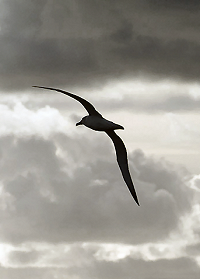
Albatrosses range over huge areas of ocean and
regularly circle the globe.
It is not known for certain why the albatrosses became
extinct in the North Atlantic, although rising sea levels
due to an interglacial warming period are thought to have
submerged the site of a Short-tailed Albatross colony that
has been excavated in Bermuda.[9] Some southern species have
occasionally turned up as vagrants in the North Atlantic and
can become exiled, remaining there for decades. One of these
exiles, a Black-browed Albatross, returned to gannet
colonies in Scotland for many years in a lonely attempt to breed.[15]
The use of
satellite tracking is teaching scientists a great deal about
the way albatrosses forage across the ocean in order to find
food. They undertake no annual migration, but disperse
widely after breeding, in the case of southern hemisphere
species, often undertaking circumpolar trips.[16] There is
also evidence that there is separation of the ranges of
different species at sea. A comparison of the foraging
niches of two related species that breed on Campbell Island,
the Campbell Albatross and the Grey-headed Albatross, showed
the Campbell Albatross primarily fed over the Campbell
Plateau whereas the Grey-Headed Albatross fed in more
pelagic, oceanic waters. Wandering Albatrosses also react
strongly to bathymetry, feeding only in waters deeper than
1000 m (3281 feet); so rigidly did the satellite plots match
this contour that one scientist remarked, "It almost appears
as if the birds notice and obey a 'No Entry' sign where the
water shallows to less than 1000 m".[8] There is also
evidence of different ranges for the two sexes of the same
species; a study of Tristan Albatrosses breeding on Gough
Island showed that males foraged to the west of
Gough and females to the east.
Diet
The albatross diet is dominated by cephalopods, fish and
crustaceans, although they will also scavenge carrion and
feed on other zooplankton.[12] It should be noted that for
most species, a comprehensive understanding of diet is only
known for the breeding season, when the albatrosses
regularly return to land and study is possible. The
importance of each of these food sources varies from species
to species, and even from population to population; some
concentrate on squid alone, others take more krill or fish.
Of the two albatross species found in Hawaii, one, the
Black-footed Albatross, takes mostly fish while the Laysan feeds on squid.
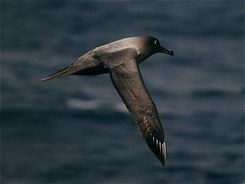
Light-mantled Sooty Albatrosses regularly dive
in order to feed and can dive to below 12m.
The use of dataloggers at sea that record ingestion of
water against time (providing a likely time of feeding)
suggest that albatross predominantly feed during the day.
Analysis of the squid beaks regurgitated by albatrosses has
shown that many of the squid eaten are too large to have
been caught alive,[17]
and include mid-water species likely to be beyond the reach
of albatross, suggesting that, for some species (like the
Wandering Albatross), scavenged squid may be an important
part of the diet. The source of these dead squid is a matter
of debate; some certainly comes from squid fisheries, but in
nature it primarily comes from the die-off that occurs after
squid spawning and the vomit of squid-eating whales (sperm
whales, pilot whales and Southern Bottlenose Whales). The
diet of other species, like the Black-browed Albatross or
the Grey-headed Albatross, is rich with smaller species of
squid that tend to sink after death, and scavenging is not
assumed to play a large role in their diet.
Until recently it was thought that albatross were
predominantly surface feeders, swimming at the surface and
snapping up squid and fish pushed to the surface by
currents, predators or death. The deployment of capillary
depth recorders, which record the maximum dive depth
undertaken by a bird (between attaching it to a bird and
recovering it when it returns to land), has shown that while
some species, like the Wandering Albatross, do not dive
deeper than a metre, some species, like the Light-mantled
Sooty Albatross, have a mean diving depth
of almost 5 m and can dive as deep as 12.5 m.[18]
In addition to surface feeding and diving, they have now
also been observed plunge diving from the air to snatch
prey.[19]
Breeding
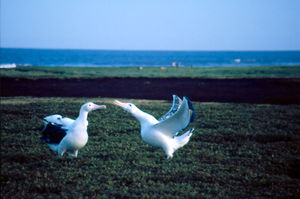
Wandering Albatrosses are colonial but have
large widely spaced territories. Here a pair
performs their famous breeding dance.
Albatrosses are colonial, usually nesting on isolated
islands; where colonies are on larger landmasses, they are
found on exposed headlands with good approaches from the sea
in several directions, like the colony on the Otago
Peninsula in Dunedin, New Zealand. Colonies vary from the
very dense aggregations favoured by the mollymawks
(Black-browed Albatross colonies on the Falkland Islands
have densities of 70 nests per 100 m˛) to the much looser
groups and widely spaced individual nests favoured by the
sooty and great albatrosses. All albatross colonies are on
islands that historically were free of land mammals.
Albatrosses are highly philopatric, meaning they will
usually return to their natal colony to breed. This tendency
to return is so strong that a study of Laysan Albatross showed that the average distance
between hatching site and the site where a bird established
its own territory was 22 metres.[20]
Like most seabirds, albatrosses are K-selected with
regard to their life history, meaning they live much longer
than other birds, they delay breeding for longer, and invest
more effort into fewer young. Albatrosses are very long
lived; most species survive upwards of 50 years, the oldest
recorded being a Northern Royal Albatross that was ringed as an adult and survived for another 51 years,
giving it an estimated age of 61.[21]
Given that most albatross ringing projects are considerably
younger than that, it is thought likely that other species
will prove to live that long and even longer.
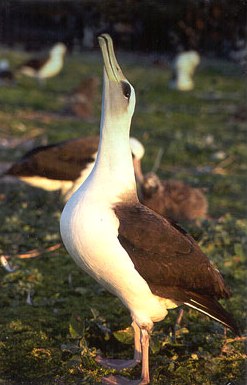
Sky-pointing is one of the stereotyped actions
of Laysan Albatross breeding dances.
Albatrosses reach
sexual maturity slowly, after about five years, but even
once they have reached maturity, they will not begin to
breed for another couple of years (even up to 10 years for
some species). Young non-breeders will attend a colony prior
to beginning to breed, spending many years practicing the
elaborate breeding rituals and "dances" that the family is
famous for.[22] Birds arriving back at the colony for the
first time already have the stereotyped behaviours that
compose albatross language, but can neither "read" that
behaviour as exhibited by other birds nor respond
appropriately.[12] After a period of trial and error
learning, the young birds learn the syntax and perfect the dances. This language is mastered
more rapidly if the younger birds are around older birds.
The repertoire of behaviour involves synchronised
performances of various actions such as preening, pointing,
calling, bill clacking, staring, and combinations of such
behaviours (like the sky-call).[23] When a bird first
returns to the colony it will dance with many partners, but
after a number of years the number of birds an individual
will interact with drops, until one partner is chosen and a
pair is formed. They then continue to perfect an individual
language that will eventually be unique to that one pair.
Having established a pair bond that will last for life, however, most of that
dance will never be used ever again.
Albatrosses are thought to undertake these elaborate and
painstaking rituals to ensure that the correct partner has
been chosen and to perfect recognition of their partner, as
egg laying and chick rearing is a huge investment. Even
species that can complete an egg-laying cycle in under a
year seldom lay eggs in consecutive years.[8]
The great albatrosses (like the Wandering Albatross) take
over a year to raise a chick from laying to fledging. Albatrosses lay a single
egg in a breeding season; if the egg is lost to
predators or accidentally broken, then no further breeding
attempts are made that year. The "divorce" of a pair is a
rare occurrence, usually only happening after several years
of breeding failure.
All the southern albatrosses create large nests for their
egg, whereas the three species in the north Pacific make
more rudimentary nests. The Waved Albatross, on the other
hand, makes no nest and will even move its egg around the
pair's territory, as much as 50 m, sometimes causing it to
lose the egg.[24] In all albatross species, both parents
incubate the egg in stints that last between one day and
three weeks. Incubation lasts around 70 to 80 days (longer
for the larger albatrosses), the longest incubation period
of any bird. It can be an energetically demanding process,
with the adult losing as much as 83 g of body weight a day.[25]
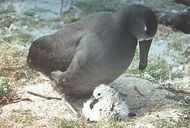
Albatrosses brood young chicks until they are
large enough to defend themselves and
thermoregulate.
After hatching, the chick is brooded and guarded for
three weeks until it is large enough to defend and
thermoregulate itself. During this period the parents feed
the chick small meals when they relieve each other from
duty. After the brooding period is over, the chick is fed in
regular intervals by both parents. The parents adopt
alternative patterns of short and long foraging trips,
providing meals that weigh around 12% of their body weight
(around 600 g). The meals are composed of both fresh squid,
fish and krill, as well as stomach oil, an energy-rich food that is lighter to carry than
undigested prey items.[26]
This oil is created in a stomach organ known as a
proventriculus from digested prey items by most tubenoses,
and gives them their distinctive musty smell.
Albatross chicks take a long time to fledge. In the case
of the great albatrosses, it can take up to 280 days; even
for the smaller albatrosses, it takes anywhere between 140
and 170 days.[27]
Like many seabirds, albatross chicks will gain enough weight
to be heavier than their parents, and prior to fledging they
use these reserves to build up body condition (particularly
growing all their flight feathers), usually fledging at the
same weight as their parents. Albatross chicks fledge on
their own and receive no further help from their parents,
who return to the nest after fledging, unaware their chick
has left. Studies of juveniles dispersing at sea have
suggested an innate migration behaviour, a genetically coded
navigation route, which helps young birds when they are
first out at sea.[28]
Albatrosses and humans
Etymology
The name albatross is derived from the
Arabic al-câdous or al-ġaţţās (a
pelican; literally, "the diver"), which travelled to
English via the
Portuguese form alcatraz ("gannet").
The OED notes that the word alcatraz was originally applied
to the frigatebird; the modification to albatross was
perhaps influenced by Latin albus, meaning "white", in contrast to
frigatebirds which are black.[12]
The Portuguese word albatroz is of
English origin.
They were once commonly known as Goonie birds or
Gooney birds, particularly those of the North
Pacific. In the southern hemisphere, the name
mollymawk is still well established in some areas, which
is a corrupted form of malle-mugge, an old Dutch name
for the Northern Fulmar. The name Diomedea, assigned to the
albatrosses by Linnaeus, references the mythical
metamorphosis of the companions of the Greek warrior
Diomedes into birds.
Albatrosses and culture
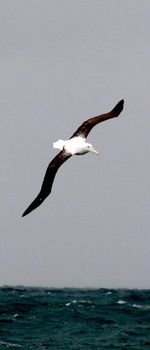
A Northern Royal Albatross in flight at the
colony in Taiaroa Head, New Zealand.
Albatrosses have been described as "the most legendary of
all birds".[27]
An albatross is a central emblem in The Rime of the Ancient
Mariner by Samuel Taylor Coleridge; a captive albatross is
also a metaphor for the počte maudit in a poem of Charles
Baudelaire. It is from the former poem that the usage of
albatross as a metaphor is derived; someone with a burden or
obstacle is said to have 'an albatross around their neck',
the punishment given in the poem to the mariner who killed
the albatross. In part due to the poem, there is a
widespread myth that sailors believe it disastrous to shoot
or harm an albatross; in truth, however, sailors regularly
killed and ate them,[15] but they were often regarded as the
souls of lost sailors. More recently, they have become part
of popular culture, for example, in a Monty Python sketch,
or the song "Echoes" by Pink Floyd. In the movie Serenity,
the character River was referred to as an albatross by The Operative,
reflecting the widespread adoption of the word as a
metaphor.
Albatrosses are popular birds for
birdwatchers and their colonies popular destinations for
ecotourists. Regular birdwatching trips are taken out of
many costal towns and cities, like Monterey, Kaikoura,
Wollongong and Sydney, to see pelagic seabirds, and
albatrosses are easily attracted to these sightseeing boats
by the deployment of fish oil into the sea. Visits to
colonies can be very popular; the Northern Royal Albatross
colony at Taiaroa Head in New Zealand attracts 40,000 visitors a
year,[8]
and more isolated colonies are regular attractions on
cruises to sub-Antarctic islands.
Threats and conservation
In spite of often being accorded legendary status,
albatrosses have not escaped either indirect or direct
pressure from humans. Early encounters with albatrosses by
Polynesians and Aleut Indians resulted in hunting and in
some cases extirpation from some islands (such as Easter
Island). As Europeans began sailing the world, they too
began to hunt albatross, "fishing" for them from boats to
serve at the table or blasting them for sport.[29] This
sport reached its peak on emigration lines bound for
Australia, and only died down when ships became too fast to
fish from, and regulations stopped the discharge of weapons
for safety reasons. In the 19th century, albatross colonies,
particularly those in the North Pacific, were harvested for
the feather trade, leading to the near extinction of the
Short-tailed Albatross.
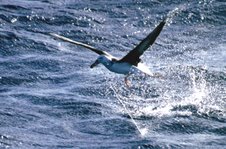
This Black-browed Albatross has been hooked on a
long-line.
Of the 21 albatross species recognised by IUCN on their
Red List, 19 are threatened, and the other two are near
threatened.[30] Two species (as recognised by the IUCN) are
considered critically endangered: the Amsterdam Albatross
and the Chatham Albatross. One of the main threats is
commercial long-line fishing,[31] as the albatrosses and
other seabirds which will readily feed on offal are
attracted to the set bait become hooked on the lines and
drown. An estimated 100,000 albatross per year are killed in
this fashion. Unregulated pirate fisheries exacerbate the problem.
Another threat to albatrosses is introduced species, such
as rats or feral cats, which directly attack the albatross
or its chicks and eggs. Albatrosses have evolved to breed on
islands where land mammals are absent and have not evolved
defences against them. Even species as small as mice can be
detrimental; on Gough Island the chicks of Tristan
Albatrosses are attacked and eaten alive by introduced house
mice that are almost 300 times smaller than they are.[32]
Introduced species can have other indirect effects: cattle
overgrazed essential cover on Amsterdam Island threatening the Amsterdam Albatross; on
other islands introduced plants reduce potential nesting
habitat.
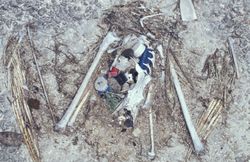
The remains of this Laysan Albatross chick show
the plastic ingested prior to death, including a
bottle cap and lighter.
Ingestion of plastic flotsam is another problem, one
faced by many seabirds. The amount of plastic in the seas
has increased dramatically since the first record in the
1960s, coming from waste discarded by ships, offshore
dumping, litter on beaches and waste washed to sea by
rivers. It is impossible to digest and takes up space in the
stomach or gizzard that should be used for food, or can
cause an obstruction that starves the bird directly. Studies
of birds in the North Pacific have shown that ingestion of
plastics results in declining body weight and body
condition.[33] This plastic is sometimes regurgitated and
fed to chicks; a study of Laysan Albatross chicks on Midway
Atoll showed large amounts of ingested plastic in
naturally dead chicks compared to healthy chicks killed in
accidents.[34]
While not the direct cause of death, this plastic causes
physiological stress and causes the chick to feel full
during feedings, reducing its food intake and the chances of
survival.
Scientists and conservationists (most importantly
BirdLife International and their partners, who run the Save
the Albatross campaign) are working with governments and
fishermen to find solutions to the threats albatrosses face.
Techniques such as setting long-line bait at night, dying
the bait blue, setting the bait underwater, increasing the
amount of weight on lines and using bird scarers can all
reduce the seabird by-catch.[35] For example, a
collaborative study between scientists and fishermen in New
Zealand successfully tested an underwater setting device for
long-liners which set the lines below the reach of
vulnerable albatross species.[36] The use of some of these
techniques in the Patagonian Toothfish fishery in the
Falkland Islands is thought to have reduced the number of
Black-browed Albatross taken by the fleet in the last 10
years.[37] Conservationists have also worked on the field of
island restoration, removing introduced species that
threaten native wildlife, which protects albatrosses from
introduced predators.
One important step towards protecting albatrosses and
other
seabirds is the 2001 treaty the Agreement on the
Conservation of Albatrosses and Petrels, which came into
force in 2004 and has been ratified by eight countries,
Australia, Ecuador, New Zealand, Spain, South Africa,
France, Peru and the United Kingdom. The treaty requires
these countries to take specific actions to reduce by-catch,
pollution and to remove introduced species from nesting
islands. The treaty has also been signed but not ratified by
another three countries, Argentina, Brazil and Chile.
Species
Current thinking divides the albatrosses into four
genera. The number of species is a matter of some debate.
The
IUCN and
BirdLife International among others recognise the
interim taxonomy of 21 extant species, other authorities
retain the more traditional 14 species, and one recent paper
proposed a reduction to 13:
-
Great albatrosses (Diomedea)
- Wandering Albatross D. exulans
Antipodean Albatross D. (exulans) antipodensis
Amsterdam Albatross D. (exulans) amsterdamensis
Tristan Albatross D. (exulans) dabbenena
Northern Royal Albatross D. (epomorpha) sanfordi
Southern Royal Albatross D. epomophora
-
North Pacific albatrosses (Phoebastria)
- Waved Albatross P. irrorata
Short-tailed Albatross P. albatrus
Black-footed Albatross P. nigripes
Laysan Albatross P. immutabilis
-
Mollymawks (Thalassarche)
- Black-browed Albatross T. melanophris
Campbell Albatross T. (melanophris) impavida
Shy Albatross T. cauta
Chatham Albatross T. (cauta) eremita
Salvin's Albatross T. (cauta) salvini
Grey-headed Albatross T. chrysostoma
Atlantic Yellow-nosed Albatross T. chlororhynchos
Indian Yellow-nosed Albatross T. (chlororhynchos)
carteri
Buller's Albatross T. bulleri
-
Sooty albatrosses (Phoebetria)
- Dark-mantled Sooty Albatross P. fusca
Light-mantled Sooty Albatross P. palpebrata.
Notes and references
- ^
Alexander, W. B., Fleming C. A., Falla R. A., Kuroda
N. H., Jouanin C., Rowan M. K., Murphy R. C.,
Serventy D. L., Salomonsen F., Ticknell W. L. N.,
Voous K. H., Warham J., Watson G. E., Winterbottom
J. M., and Bourne W. R. P. 1965. "Correspondence:
The families and genera of the petrels and their
names." Ibis 107: 401-5.
- ^
Nunn, G. B., Cooper, J., Jouventin, P., Robertson,
C. J. R. and Robertson G. G. (1996) "Evolutionary
relationships among extant albatrosses
(Procellariiformes: Diomedeidae) established from
complete cytochrome-b gene sequences". Auk
113: 784-801.
[1]
- ^
a b
Double, M.C. & Chambers, G.K., (2004). "The need for
the parties to the Agreement on Albatrosses and
Petrels (ACAP) to establish a robust, defendable and
transparent decision-making process for the
construction and maintenance of their species lists
". Proceedings of the Scientific Meeting of
Agreement on Albatrosses and Petrels (ACAP),
Hobart, Australia, 8-9 November 2004[2]
- ^
Robertson, C. J. R. and Nunn, G. B. (1998) "Towards
a new taxonomy for albatrosses" in: Proceedings
First International Conference on the Biology and
Conservation of Albatrosses, G.Robertson &
R.Gales (Eds), Chipping Norton:Surrey Beatty & Sons,
13-19,
- ^
Burg, T.M., & Croxall, J.P., (2004) "Global
population structure and taxonomy of the wandering
albatross species complex". Molecular Ecology
13: 2345-2355.
[3]
- ^
Penhallurick, J. and Wink, M. (2004). "Analysis of
the taxonomy and nomenclature of the
Procellariformes based on complete nucleotide
sequences of the mitochondrial cytochrome b gene."
Emu 104: 125-147.
- ^
Rheindt, F. E. & Austin, J., (2005) "Major
analytical and conceptual shortcomings in a recent
taxonomic revision of the Procellariiformes - A
reply to Penhallurick and Wink (2004), Emu
105: 181-186
[4]
- ^
a b c d
Brooke, M. (2004). Albatrosses And Petrels Across
The World Oxford University Press, Oxford, UK
ISBN 0-19-850125-0
- ^
a b
Olson, S.L., Hearty, P.J. (2003) "Probable
extirpation of a breeding colony of Short-tailed
Albatross (Phoebastria albatrus) on Bermuda
by Pleistocene sea-level rise." Proceedings of
the National Academy of Science 100: (22)
12825-12829.
- ^
Lequette, B., Verheyden, C., Jowentin, P. (1989)
"Olfaction in Subantarctic seabirds: Its
phylogenetic and ecological significance" The
Condor 91: 732-135.
[5]
- ^
Pennycuick, C. J. (1982). "The flight of petrels and
albatrosses (Procellariiformes), observed in South
Georgia and its vicinity". Philosophical
Transactions of the Royal Society of London B
300: 75–106.
- ^
a b c d
Tickell, W.L.N. (2000). Albatrosses.
Sussex:Pica Press,
ISBN 1-873403-94-1
- ^
Weimerskirch H, Guionnet T, Martin J, Shaffer SA,
Costa DP. (2000) "Fast and fuel efficient? Optimal
use of wind by flying albatrosses." Proc Biol Sci
267: (1455) 1869-74.
- ^
Warham, J. (1996). The Behaviour, Population,
Biology and Physiology of the Petrels.
London:Academic Press,
ISBN 0-12-735415-8
- ^
a b
Cocker, M., & Mabey, R., (2005) Birds Britannica
London:Chatto & Windus,
ISBN 0-7011-6907-9
- ^
Croxall, J. P., Silk, J.R.D., Phillips, R.A.,
Afanasyev, V., Briggs, D.R., (2005) "Global
Circumnaviagtions: Tracking year-round ranges of
nonbreeding Albatrosses" Science 307:
249-250.
- ^
Croxall, J.P. & Prince, P.A. (1994). "Dead or alive,
night or day: how do albatrosses catch squid?"
Antarctic Science 6: 155–162.
- ^
Prince, P.A., Huin, N., Weimerskirch, H., (1994)
"Diving depths of albatrosses" Antarctic Science
6: (3) 353-354.
- ^
Cobley, N.D., (1996) "An observation of live prey
capture by a Black-browed Albatross Diomedea
melanophrys " Marine Ornithology 24:
45-46.[6]
- ^
Fisher, H.I., (1976) "Some dynamics of a breeding
colony of Laysan Albatrosses. Wilson Bulletin
88: 121-142.
- ^
Robertson, C.J.R. (1993). "Survival and longevity of
the Northern Royal Albatross Diomedea epomophora
sanfordi at Taiaroa Head" 1937-93. Emu
93: 269-276.
- ^
Jouventin, P., Monicault, G. de & Blosseville, J.M.
(1981) "La danse de l'albatros, Phoebetria fusca".
Behaviour 78: 43-80.
- ^
Pickering, S.P.C., & Berrow, S.D., (2001) "Courtship
behaviour of the Wandering Albatross Diomedea
exulans at Bird Island, South Georgia" Marine
Ornithology 29: 29-37
[7]
- ^
Anderson, D.J. & Cruz, F. (1998) "Biology and
management of the Waved Albatross at the Galapagos
Islands. Pp.105-109 in Albatross Biology and
Conservation (Roberston , G. & Gales, R. eds)
Chipping Norton:Surrey Beatty and & Sons
ISBN 0-949324-82-5
- ^
Warham, J. (1990) The Petrels - Their Ecology and
Breeding Systems London:Academic Press.
- ^
Warham, J. (1976) "The incidence, function and
ecological significance of petrel stomach oils."
Proceedings of the New Zealand Ecological Society
24: 84-93
[8]
- ^
a b
Carboneras, C. (1992) "Family Diomedeidae
(Albatross)" in Handbook of Birds of the World
Vol 1. Barcelona:Lynx Edicions,
ISBN 84-87334-10-5
- ^
Ĺkesson, S., & Weimerskirch, H., (2005) "Albatross
Long-Distance Navigation: Comparing Adults And
Juveniles" Journal of Navigation 58:
365-373.
- ^
Safina, C. (2002) Eye of the Albatross: Visions
of Hope and Survival New York:Henry Holt &
Company
ISBN 0-8050-6229-7
- ^
IUCN, 2004.
Red List: Albatross Species. Retrieved
September 13, 2005.
- ^
Brothers NP. 1991. "Albatross mortality and
associated bait loss in the Japanese longline
fishery in the southern ocean." Biological
Conservation 55: 255-268.
- ^
BBC News, 2005.
Albatross chicks attacked by mice. Retrieved
March 6, 2006.
- ^
Spear, L.B., Ainley, D.G. & Ribic, C.A. (1995).
"Incidence of plastic in seabirds from the tropical
Pacific, 1984–91: relation with distribution of
species, sex, age, season, year and body weight."
Marine Environmental Research 40:
123–146.
- ^
Auman, H.J., Ludwig, J.P., Giesy, J.P., Colborn, T.,
(1997) "Plastic ingestion by Laysan Albatross chicks
on Sand Island, Midway Atoll, in 1994 and 1995." in
Albatross Biology and Conservation, (ed by G.
Robinson and R. Gales). Surrey Beatty &
Sons:Chipping Norton. Pp. 239-44
[9]
- ^
Food and Agriculture Organisation (1999) "The
incidental catch of seabirds by longline fisheries:
worldwide review and technical guidelines for
mitigation. FAO Fisheries Circular No.937. Food and
Agriculture Organization of the United Nations,
Rome.
[10]
- ^
O'Toole, Decland & Molloy, Janice (2000)
"Preliminary performance assessment of an underwater
line setting device for pelagic longline fishing"
New Zealand Journal of Marine and Freshwater
Research 34: 455-461.
[11]
- ^
Reid, A.T., Sullivan, B.J., Pompert,J., Enticott,
J.W., Black, A.D., (2004) "Seabird mortality
associated with Patagonian Toothfish (Dissostichus
eleginoides) longliners in Falkland Islands
waters." Emu 104: (4) 317-325.
External links




